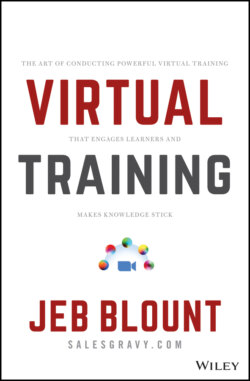Читать книгу Virtual Training - Blount Jeb, Jeb Blount - Страница 11
Оглавление4 Experience Is Everything
As our virtual training business exploded, many of my peers in our industry segment called to ask (and learn) about how we’d so quickly pivoted from in-classroom training to virtual. After I shared my story about building our virtual training studios, the responses that followed were typically along the lines of:
“Wow, you are way ahead of the curve.”
“Your timing was impeccable.”
“You are so far ahead of everyone else.”
“You really got lucky.”
I heard “You got lucky” a lot. Even from my own family. Trust me, in the moment, with so many other training companies taking it on the chin because they were not able to switch to virtual, I felt lucky.
But it wasn't luck. It was the cumulation of years of observation, experimentation, and hard work. A long time ago, we had recognized that virtual instructor-led training was important, and it was a methodology that we would need to master to be competitive in the future. We understood what didn't work, and why people have an aversion to virtual training. We also knew what we didn't like about delivering virtual training.
We were convinced that the biggest obstacle to gaining wider adoption of virtual training was the experience. Too often, VILT felt impersonal, low-energy, two-dimensional, and uncollaborative. For most learners it was about enduring a painfully boring and awful experience rather than engaging in actual learning.
The good news is that it's possible to control most of the things that make virtual training so bad:
Instructors who are unprepared or not trained to teach effectively in the virtual classroom
Poor training delivery methods and practices
Suboptimal virtual training production, including lackluster video, audio, backdrops, and framing
Media and graphics ill-suited for on-screen viewing
Failure to adopt and master the technology required to effectively manage a virtual classroom
Poor instructional design
Treating virtual training as an afterthought
All of these elements and more are easily resolved, if you have the will and desire to do so. This begins and ends with a focus on the mission.
Five Truths About Virtual Training Adoption
The most frequent concerns that learning and development professionals have about virtual is that clients, internal customers, and learners won't accept it. This was our biggest worry, too, but our experience has taught us five truths:
1 Most people prefer face-to-face training over virtual training—especially if they have had a bad experience with VILT in the past, which many have.
2 If the only option for training is virtual, most customers (the people paying for or ordering training) will begrudgingly accept that option.
3 If the cost (including travel, materials, and lost productivity) of virtual training compared to physical training is similar, most customers will choose classroom-based training.
4 If the cost gap (including travel, materials, and lost productivity) between virtual and physical training is large, most customers will strongly consider and often choose virtual training over classroom-based.
5 When the virtual training experience is outstanding, clients and learners are much more likely to choose VILT over classroom-based training for future deliveries, and they will book more future trainings than they would if they were only considering in-person sessions.
The brutal truth is that the experience matters more than anything. When you make VILT a great experience for your stakeholders (customers and learners), they'll begin to trust it and be open to more.
The one thing you can take to the bank, though, is that they won't accept virtual training if the experience is awful—no matter what the cost. If the choice is between affordable but bad VILT and unaffordable in-person training, customers will choose no training at all.
There are few people who haven't had the pleasure of sitting through agonizing virtual training sessions. Death by voice-over PowerPoint, delivered by a disengaged or clueless instructor, has an especially bitter flavor. I remember watching in dismay as my son endured one of his professors drone on for 20 minutes in a completely monotone voice-over while a single slide with 10 small bullet points filled the screen. The professor's audio was bad, and he never showed his face on video. Not once did he ask a question or engage his students. There wasn't even any movement on the slide. It was excruciating. My son drifted off into an app on his phone. I was livid that I was paying his private university $40,000 a year for this crap, and I fired off a scathing email to the president of his college.
This was exactly why so many of the executives we worked with were dead set against virtual training. It was why our clients' stakeholders believed that the cost for virtual training should be a fraction of what they paid for classroom training.
The reason there has been so much resistance from leaders, trainers, and participants to virtual training is because the experience has been awful. It's not because of the quality of the curriculum or content. It's not because of the talent of the trainer. It's the experience.
What matters most is the way virtual training is delivered and how it makes both the trainer and the participants feel. When the virtual learning experience is emotionally positive:
Participants are more engaged, readily embrace new competencies, and the training sticks.
Participants are more likely to show up to class and be open to future virtual training.
Trainers enjoy their work and gain fulfillment from making an impact.
Leaders book more virtual training and are willing to pay a premium for it.
Organizations blend and integrate VILT into learning and development initiatives.
The real secret to gaining widespread acceptance for virtual training is delivering an exceptional virtual learning experience.
